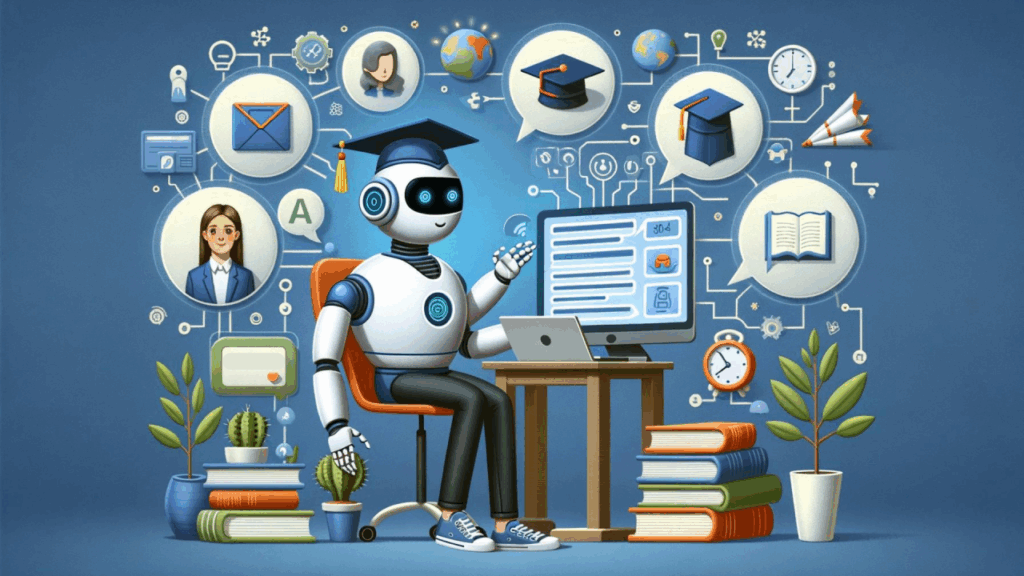The digital revolution has had a profound impact on education. Communication issues can often be a barrier to international education, which is a shame because it can be a rewarding experience. Imagine being a Chinese or Brazilian student who is trying to understand the professor’s message. Imagine that you all live in different time zones. Communication barriers are a major problem for international students and professors.
AI chatbots can be very useful in this case, thanks to the advanced algorithms. They not only provide a communication bridge, but also make students more interactive through personalized support. The learning environment becomes inclusive and more effective. This paper will present AI chatbots as a way to overcome the communication barriers in international education.
Communication Barriers in International Education
Language differences
The language barrier is one of the largest communication barriers in education. Both teachers and students find it difficult to communicate effectively. Students from Japan who study in the United States may struggle with English. It could affect the student’s academic performance and learning experience. Teachers may have difficulty explaining complex concepts to a multidisciplinary classroom.
The language barrier is not just about words and pronunciation. It also includes cultural references, local dialects, and academic terms that are unfamiliar to non-native speakers. All of these can make it difficult for students to participate in class discussions or understand course material.
Cultural Differences
Cultural differences can also impact communication issues. Each culture has unique values, norms, and communication structures, which may lead to misunderstood expectations; students from collectivist cultures may struggle when joining groups where assertiveness-typical of more individualistic cultures expected.
Nonverbal communication, such as body language, facial expressions, and gestures, can be influenced by culture. Non-verbal communication can be crucial to effective intercultural interactions, but misinterpretation could lead to miscommunication.
Time Zone Problems
The time zone differences can be a challenge for global learning programs that span several time zones. It can be difficult to schedule meetings, group work sessions, and live chats across time zones. This reduces communication and collaboration potential and makes students feel isolated if they are forced to work during odd hours to accommodate others.
Accessibility of technology
Although technology can connect people, it is sometimes limited in its availability. Students who do not have reliable internet access and/or appropriate devices will struggle to engage in online learning. This can lead to a digital divide that hinders effective communication, learning, and interaction.
AI Chatbots Bridge Communication Gaps

Translation and Interpreting Languages
AI chatbots with advanced translation and interpreting algorithms reduce language barriers. They translate both text and voice in real-time, allowing students, educators, and peers to communicate despite their language differences. A chatbot can instantly translate a question from a student into the professor’s native language to provide an immediate solution.
Chatbots are also able to decode academic jargon, including technospeak and technical terms. This allows for a smoother delivery of complex concepts. It not only improves understanding but also encourages interaction by reducing anxiety about language usage.
Cultural Sensitivity & Adaptability
AI-enabled chatbots can be programmed in order to understand the cultural differences of communication. Chatbots are able to adapt their speech style according to the cultural expectations of users for productive interactions.
AI chatbots can also help teachers and students better understand cultural differences. They will be able to relate and communicate with each other. A chatbot could, for example, explain cultural references and behaviors to its users while spreading awareness.
Time Zone Coordination
AI chatbots are a great way to improve cross-time zone communication by automating tasks like scheduling meetings and sending out reminders. This reduces the risk of miscommunication while strengthening collaboration relationships.
Chatbots offer asynchronous assistance to students, giving them access to information at any time and allowing for better learning across time zones.
Accessibility Improvements
AI chatbots provide a new way for people with limited technology to access education. These AI bots can be used across multiple platforms, including mobile apps and social media.
Chatbots provide tailored learning resources for every student. They can, for example, deliver content with audio or text-to-speech features that meet learning styles and accessibility requirements.
Artificial Intelligence Chatbots Revolutionize Global Education

Personalized Learning Support
AI chatbots are excellent at providing customized learning support. AI chatbots are able to offer customized feedback and resources by analyzing student data.
Students can benefit from tailored support that helps them overcome obstacles, boost their academic performance, and build confidence.
Interaction and engagement increased
AI chatbots improve learning engagement. They provide instant feedback, respond quickly to questions and encourage participation in discussion topics.
These environments create a safe and non-judgmental environment where students can freely express themselves – a valuable benefit for shy or introverted students who have difficulty speaking up in traditional classroom settings.
Effective Administrative Support
Artificial intelligence chatbots are a great way to help educators streamline administrative tasks such as scheduling, sending out reminders, and disseminating important information. This allows them to concentrate on teaching and mentoring students.
These institutions are excellent at welcoming and guiding new students through academic systems and provide essential information to make the transition easier into new learning environments. This enriches student experiences and increases retention rates.
Case Studies and Practical Applications is an important part of modern life.

University of California at Berkeley
UC Berkeley implemented chatbots that provide real-time translation, cultural sensitivity support, and academic assistance tailored specifically for international study abroad students. These chatbots can also help students overcome potential obstacles associated with studying abroad.
Chatbots are a great way to increase student engagement. They give students instant access to information and help, ultimately improving academic and social outcomes.
University of Melbourne
The University of Melbourne uses AI chatbots in order to foster collaboration between international students. Chatbots can help students communicate in a foreign language, manage time zones, and provide tailored instruction.
By overcoming language barriers, chatbots enable universities to enhance academic performance and encourage greater participation from their diverse student population.
Future Prospects & Developments
Chatbots are becoming more important in international education as AI improves. Future chatbots could include sophisticated natural language processing abilities that allow them to recognize nuanced and complex communication.
Virtual and augmented realities could provide immersive, engaging learning experiences. AI chatbots will be able to reach more students around the world with these advances.
Chatbots can be used to provide high-quality services for students across the country.
The conclusion of the article is:
AI chatbots have revolutionized international education, removing long-standing barriers to communication between students and teachers. Chatbots create more inclusive and immersive learning environments by offering features like real-time translation and cultural sensitivity monitoring.
AI chatbots revolutionize education by providing personalized teaching, increased engagement, and smooth administration. These benefits will only increase as AI chatbots develop further. Chatbots are set to continue playing a greater role in helping international students thrive within a connected academic landscape.




